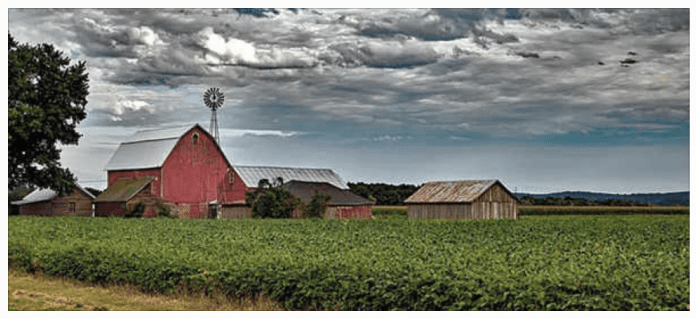You can’t take it ALL with you, but if you want to survive, you better start planning right now to evacuate from your homestead with your food and water preps, intact.
Grabbing what you can and going is not a plan, it is a recipe for failure…especially if you did not diligently set up the homestead in preparation for a possible disaster and run drill after drill with your loved ones to pack up and get out as quickly as possible.
Top 6 Things to Take with You when Evacuating the Homestead
1. Food – Crops ready to harvest, the seeds you have stored, long-term storage food, and livestock feed.
2. Water – Potable water for humans and livestock, water purification tablets, and other supplies.
3. Medicine – Prescription, over the counter, natural medicine from your home apothecary (i.e. essential oils, herbs, roots, medicinal flowers), advanced medical preps, first aid kits.
4. Shelter – Whether it is tents, tarps, campers, or converted livestock trailers, some means of protection from the elements must be taken with you when evacuating the homestead and it must be portable enough to be not cause added time or a resources (human and material) drain to the overall evacuation plan.
5. Livestock – The animals, as many as is feasible, must evacuate from the homestead with the prepping family or mutual assistance group. The animals are a source of meat, eggs, milk, and warmth – if you tan their hides. Manual butchering equipment must also have a space on the vehicles and trailers leaving the homestead.
6. Library – Cross-training is (or at least should be) a cornerstone on the prepping homestead. But, do not expect yourself or your loved ones to have mastered and remember every bit of knowledge that they will need to survive after fleeing the homestead. A plastic tote with books or binders of essential information should be kept at the ready and placed on the first load of essential gear leaving the property.
Related: 17 Survival Uses for Safety Pins
Homestead Evacuation Planning
Cars
The first step in planning an evacuation from the homestead is to determine how many vehicles will be leaving the property, this number will depend on not only how many vehicles you have, but the number of drivers and OPSEC concerns related to conditions outside of the land and on the open road.
For the purpose of this article, we will presume the SHTF and for some reason, the homestead location is compromised and the family must leave. In such a scenario, traffic laws will not be a concern.


ATVs and Tractors
In SHTF situations, you could drive your 4-wheeler or similar ATVs on the roads. It also means you could drive your tractor or beat-up old farm truck that hasn’t had a license tag on it in years.
During such a situation, you drivers will not need to be licensed. It is a common practice in rural areas, where the bulk of homestead are located, to teach children how to drive around the land and on-farm equipment, at an early age – usually around 13 or 14 years old.
Your young teenager may be entirely capable of driving a vehicle or ATV from the homestead during the evacuation, he or she may also be great a backing up the vehicle when it is towing a trailer – but will the roads be safe enough to put them out there alone (which is what they would be even if you are in a vehicle right in front of or behind them” during a SHTF evacuation scenario.
Only you will know the answer to that question, and may not even know for sure until the situation is unfolding and you can better gauge the presence of roadway threats. Putting a responsible and mature young teen driver behind the wheel is not a bad idea, but due to the parental safety concerns that could likely arise, you should not write such a plan in store by assigning the teen to drive an ATV pulling essential cargo during the evacuation.
Putting the youth at the helm inside a car, truck, or motor home might be the best idea. Fretting about the safety of a young loved one driving or riding extremely exposed when outside of a vehicle, could be too much of a distraction and impede the evacuation at some time along the travel route.
All ATVs, trucks, and SUVs should be equipped with a wench, a hitch, and spare tires. These items, along with a box with more small space parts and tools – including a charge power drill with a charged spare battery, should be constantly stored in the vehicles.
Related: DIY $20 Survival Food Bucket
Moving Trucks – Transportation and Shelter
Purchasing an old Uhaul style truck will offer copious amounts of evacuation possibilities. The truck obviously offers ample interior hauling space and the roof could be used to pack more items – especially square bales of hay for the livestock.
The moving truck could double as a living space for the family or the livestock after evacuating the survival homestead, as well. If such a truck will be a part of the evacuation plan, it should be dedicated solely for that purpose. Once purchased, the truck should immediately be prepared for its intended purpose by having storage shelves built inside, a chicken coop and cordoned off goat pen established, or living quarters created.
You could use the moving truck as your portable pantry and apothecary and store those homesteading preps inside on a regular basis so those essentials are immediately ready to leave when the evacuation alarm is sounded. A portion of your water supply and the preparedness binder resource library should also have a designated and permanent spot inside the remodeled moving truck.
Build “closets” onto the sides of the old moving truck. Wood shelving units with doors than can be locked and opened vastly increase the amount of cargo space. Wall panels and a roof, made from wood, metal, or tarps, will help protect and gear, hay, or straw carried on top of the truck and again, increase the number of supplies that can be evacuated in one vehicle by one driver. If all of the available people from the homestead are driving the fleeing vehicles, there will be no one left to literally, “ride shotgun.”


School Buses – Transportation and Shelter
If you can find an old school bus at a junkyard or auction (they are more readily available than you might think) they could easily be worth the time and money to turn them into a bugout vehicle for use when evacuating the homestead.
School buses can be used to haul people, animals, and gear, and then used as living quarters. Turning school buses into mobile tiny houses have grown quite popular, and for great reason. The buses offer ample space for living and storage inside and after a frame is built on the roof of the bus, even more, storage room is available.
If you can find an old double-decker tour bus, or build onto a typical bus to give it a second story, you truly will have a house on wheels, if you have to evacuate the homestead.
A school bus could be used as an intact and mobile barn for multiple types of small and medium livestock if sections of seats are removed. A floor to ceiling chicken coop could be constructed in the back of the busy, with the emergency entry door used to get inside to collect eggs from nesting boxes. Make a wooden ramp for the back exit so the chickens can leave their mobile coop when necessary.
The bus could be used as a full-time barn so the animals are already situated with living space, to enhance the ease and speed of evacuation, or set up in advance and kept in reserve for a SHTF emergency.
Roosts and even swings could be suspended from the roof of the bus. Construct a frame for the interior bus side of the coop out of wood and hardware cloth or chicken wire, including a door for added access.
Take the seats out of one side of the bus and fence the area in so it can house pigs, goats, and/or sheep. The side of the bus where seats remain and are used for feed, straw, and hay storage. A school bus would be too short for housing horses but could be used as a mobile barn for ponies, miniature horses, miniature donkeys (which are supreme coyote hunters!) and cows.
Related: 3 Things Every Prepper Must Realize
Trailers
Pull behind trailers, livestock trailers, and hay wagons should be at the top of your survival shopping list if you are a prepping homesteader who is planning for a possible emergency evacuation. A trailer should be attached to each vehicle when it leaves the homestead – even if you will be leaving in a motor home.
If the trailers will not be used around the homestead on a regular basis, remodel them for their intended evacuation use. A small livestock trailer designed to transport cows, hogs, and goats, would make a great portable chicken coup or pantry.
Large livestock trailers can become multi-livestock barns by using the available space wisely. Rabbit cages mounted to the sides of the trailer or suspended for the roof will take up little square footage in the trailer.
Cordoning off a small floor to ceiling area will give your chicken and duck flocks a place for both transport and to live after leaving the homestead. Screw a wood sawhorse into the floor of the area to make the base for a roost and then screw some 2X2 boards on top of the sawhorse to give the flock a space to sit.
Purchase hanging water with a top and fountain style dispensers to save space and prevent spilling of valuable water while on the move. Plastic storage totes turned sideways and screwed into the wall and/or floor will provide nesting and sleeping areas. Mount a PVC pipe with an elbow bend at the bottom to the wall of the truck to create a relatively spill-free feeding area. To make a water area for the duck to use after an evacuation, purchase to baby pools.
One will be screwed into the floor and serve as a base and an identical pool will be placed on top of it to actually hold water when the vehicle is not moving. Straw could be placed in the baby pool during transport to give the ducks a safe place to travel.
Build sturdy wood shelving units along a section of the wall to house livestock feed. You will need strong netting or wood front boards to keep the bags of feed in place during transport. Do not skip this step and just toss the bags on the floor, the animals could somehow get into it while traveling and it could be soaked in livestock urine and feces. If you are a homesteader, you already know what great escape artists some critters can be!
Portable electric fencing, even versions small enough to house chickens and ducks if you throw a piece of bird netting on top, exist and are not expensive. Purchasing this type of fencing, or traditional electrical fencing, the small and lightweight metal posts it requires, and a solar charger will give you quick and easy pasture for the livestock after evacuation. Build a ceiling-mounted storage area to house the fencing and animal feeders during transport to avoid taking up valuable floor space.
Affix hooks to the ceiling throughout the trailer so solar lanterns can be hung from during transport. Old-fashioned glass lanterns are great, I love ours, but they break easily and do not run on a sustainable fuel. Purchase as many solar lanterns and landscaping lights (often sold at Dollar Tree) as you can find to provide light when necessary post-evacuation.
The ceiling of livestock trailers would be an otherwise wasted space if lightweight items like the solar lanterns are not hung from them – use every single available inch of space in, on, around, and under all of the vehicles and pull behinds to avoid having to leave behind any necessary gear or cherished family keepsakes, like photo albums.
Build wood or metal walls onto our flatbed trailers to increase their ability to carry gear and to protect it from easy attack. If large items are not going to be toted on the trailers, consider putting a roof on the flatbed trailers as well. A roof would allow the trailers to be used as a temporary emergency shelter for either the prepping family or livestock.
You can turn even a 2-horse bumper pull horse trailer cargo trailer, into living quarters. Space will be limited, but a sleeping area with room for a composting commode and some storage areas (especially if you take advantage of the ceiling area by building a suspended rack) do exist.
A larger livestock trailer, like the type you often see semi-trucks pulling down the highway, would allow for a lot more living and storage space for the homesteading prepper family. Many versions of these livestock trailers have a multitude of open slits on the sides to enhance ventilation. If you cannot find a more full panel large livestock trailer, boarding up the slits and perhaps putting in a wall of insulation, will be necessary to keep the family warm during the cool weather months. All large livestock trailers have gooseneck hitches. You will need a gooseneck receptacle in the truck that will pull the trailer. The receptacles take up a lot of bed space and will vastly reduce the amount of survival kit storage available in the back of the truck.
Make it Mobile
The more aspects of your homestead that are built in a mobile manner, even though they will be used in a traditional stationary way on a daily basis, the better prepared you will be for a SHTF evacuation. When using a trailer of the same type as the base of the mobile homesteading structure, always place it on the ground that is not likely to get extremely muddy and place the hitch pole support on top of a cinder block so it remains raised enough to back a truck up to it to connect.
Once you have your mobile unit complete and filled, hitch it up and pull it around the homestead and out onto the road, including up and down hills and around corners, to make sure it is both sturdy and not too top-heavy – or too heavy in general, to be hauled.
• Greenhouse – Turn a flatbed trailer into a mobile greenhouse by framing it out with wood and covering it with a thick gauge plastic. Build a secured wood work table with a framed edge around it for tending to plants and seed starting trays. Make built-in wood or metal storage benches that lock around the base of the walls to store seeds, gardening tools, growing containers, potting soil, and to even use as compost bins.
• Portable Growing – In addition to your typical homestead gardening plot, grow as many crops in containers as you can haul during an evacuation. Grow potatoes in buckets or in a plastic tote of a 55-gallon drum, tomatoes in containers, lettuce and other short-root crops in planting boxes that can be screwed into a trailer, moving truck, or bus wall or placed on a shelf with a webbing front or cage to keep them in place. Add dwarf fruit trees to your food cultivation activities, they need large containers to grow in but are also a great portable crop.
• Water Storage – Turn a cargo trailer or small livestock trailer into a portable water house. Not only can you store water jugs, pouches, bladders, and 55-gallon drums, drip hose irrigation system materials you may need once the growing season begins again after the homestead relocation, and purification supplies inside, you can affix eaves trough to the exterior of the trailer (and all other trailers on the homestead) and turn it into a rainwater collection system.
• Solar Power – Purchase solar generators and use them to power the water pump on a portable tiny home, tools, etc. These generators should be stored in the mobile unit, if at all possible. Go low-tech solar and paint 2-liter plastic bottles black and mount them together on a wood frame that is attached to the sides of the mobile tiny house, greenhouse, and/or portable barn to help keep the humans, animals, and contents inside as warm as possible during the winter.
• Camping Gear – Furniture, lighting, and cooking supplies designed for camping are lightweight, portable, and often designed so they collapse into a more compact dimension. A camping kitchen is basically a plastic table with folding legs and metal slotted shelving attachments designed to enhance the food preparation area.
Folding and hanging camping kitchen “cabinets” hang on branches of trees to keep food away from predators below. The cabinets can be hung on hooks inside mobile units and either kept thereafter the homestead evacuation of hung from trees in an area set up for an outside kitchen while on the move. A folding canopy condenses down and is stored in a durable bag that is usually not large than 8 inches by four feet.
The bags come with a handle, allowing them too to be hung from a ceiling and take up little space in a mobile unit. Some of the canopy sets come with wall attachments that can be quickly attached to turn the canopy into a full-fledged tent. Three-season tents with separated rooms and a small amount of hanging mesh pocket storage would give the family somewhere warm to live and allow the trailers being hauled to house more gear, food, weapons, and livestock. A portable rocket stove designed either for camping or survival will allow you to heat water and food in record time, even when only a little or damp kindling is all that can be found.
• Fuel – You will only get as far as the fuel you have stockpiled and can carry when evacuating the homestead, will take you. Consider converting your vehicles to run on alternative fuel so you can more cheaply stockpile the ingredients to make a more shelf-stable fuel. Learning how to make your own fuel on a still will be an advantage until the available ingredients run out. Converting trucks to run on wood-powered fuel will likely give you the most abundant fuel source.
Final Words
Creating the most sustainable survival retreat you can by engaging in traditional homesteading practices makes good sense. Planning for the day something beyond your control could force you off the homestead, makes even better sense.
Diligent planning to create a mobile homesteading survival retreat that melds into the daily functions on the property will not only save you time and money, but it might also just save your life one day.





















